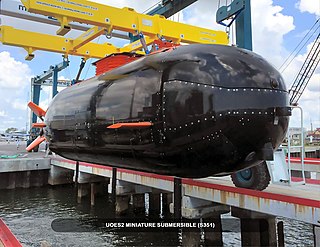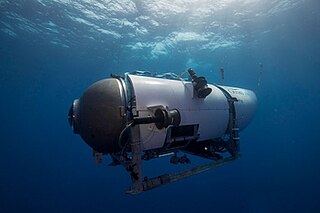An underwater environment is a environment of, and immersed in, liquid water in a natural or artificial feature, such as an ocean, sea, lake, pond, reservoir, river, canal, or aquifer. Some characteristics of the underwater environment are universal, but many depend on the local situation.

A submersible is an underwater craft which needs to be transported and supported by a surface vessel or platform. This distinguishes submersibles from submarines, which are self-supporting and capable of independent operation.

A diver propulsion vehicle (DPV), also known as an underwater propulsion vehicle, sea scooter, underwater scooter, or swimmer delivery vehicle (SDV) by armed forces, is an item of diving equipment used by scuba divers to increase range underwater. Range is restricted by the amount of breathing gas that can be carried, the rate at which that breathing gas is consumed, and the battery power of the DPV. Time limits imposed on the diver by decompression requirements may also limit safe range in practice. DPVs have recreational, scientific and military applications.

A midget submarine is any submarine under 150 tons, typically operated by a crew of one or two but sometimes up to six or nine, with little or no on-board living accommodation. They normally work with mother ships, from which they are launched and recovered and which provide living accommodation for the crew and support staff.

Human torpedoes or manned torpedoes are a type of diver propulsion vehicle on which the diver rides, generally in a seated position behind a fairing. They were used as secret naval weapons in World War II. The basic concept is still in use.

A deep-submergence vehicle (DSV) is a deep-diving crewed submersible that is self-propelled. Several navies operate vehicles that can be accurately described as DSVs. DSVs are commonly divided into two types: research DSVs, which are used for exploration and surveying, and DSRVs, which are intended to be used for rescuing the crew of a sunken navy submarine, clandestine (espionage) missions, or both. DSRVs are equipped with docking chambers to allow personnel ingress and egress via a manhole.

An atmospheric diving suit (ADS) is a small one-person articulated submersible which resembles a suit of armour, with elaborate pressure joints to allow articulation while maintaining an internal pressure of one atmosphere. An ADS can enable diving at depths of up to 700 metres (2,300 ft) for many hours by eliminating the majority of significant physiological dangers associated with deep diving. The occupant of an ADS does not need to decompress, and there is no need for special breathing gas mixtures, so there is little danger of decompression sickness or nitrogen narcosis when the ADS is functioning properly. An ADS can permit less skilled swimmers to complete deep dives, albeit at the expense of dexterity.

Mir was a class of two self-propelled deep-submergence vehicles. The project was initially developed by the USSR Academy of Sciences along with Lazurit Central Design Bureau, and two vehicles were ordered from Finland. The Mir-1 and Mir-2, delivered in 1987, were designed and built by the Finnish company Rauma-Repola's Oceanics subsidiary. The project was carried out under the supervision of constructors and engineers of the Shirshov Institute of Oceanology.

The Advanced SEAL Delivery System (ASDS) was a midget submarine operated by the United States Navy and United States Special Operations Command. It provided stealthy submerged transportation for United States Navy SEALs from the decks of nuclear submarines for use as an insertion platform for covert and clandestine special operations missions. The ASDS was canceled in 2009 due to cost overruns and reliability issues, after the prototype was destroyed in a fire in 2008. As of 2019, the Navy plans to replace the ASDS with the Dry Combat Submersible, a similar midget submarine being developed by Lockheed Martin.

Johnson Sea Link was a type of deep-sea scientific research submersible built by Edwin Albert Link. Link built the first submersible, Johnson Sea Link I, in 1971 at the request of his friend Seward Johnson, founder of the Harbor Branch Oceanographic Institute. It was the successor to Link's previous submersible, Deep Diver, which had been determined to be unsafe for use at great depths or in extremely cold temperatures. Johnson Sea Link II was built in 1975.
Cheyenne, formerly known as PlayStation is a large catamaran created for the 2000 around the world race known as The Race. Like its competitors, Cheyenne was created for sheer speed, pushing the state of the art in materials, construction, and operation. PlayStation was skippered and owned by Steve Fossett. It is owned by and operated by Virgin Oceanic's co-founder Chris Welsh.

Pisces-class submersibles are three-person research deep-submergence vehicles designed and built by Hyco International Hydrodynamics of North Vancouver in British Columbia with a maximum operating depth of 2,000 m (6,560 ft). The vehicles have multiple view ports and sample collecting, environmental sensing, and instrument placement capabilities. The pressure hull has a 7 ft (2.1 m) inside diameter and is made of HY-100 steel with three forward-looking acrylic windows, 6 in (15 cm) in diameter. Designed by Allan Trice, the Pisces series of submersibles were representative of crewed submersibles built in the late 1960s and were proven workhorses in offshore exploration and oceanographic research. Pisces II was the first production model of the design and was completed in 1968, with nine more Pisces submarines built before the manufacturer went out of business in the late 1970s.
Joseph Beverly MacInnis D.Sc. is a Canadian physician, author, and diver. In 1974, MacInnis was the first scientist to dive in the near-freezing waters beneath the North Pole. In 1976 he became a member of the Order of Canada.

Deepsea Challenger is a 7.3-metre (24 ft) deep-diving submersible designed to reach the bottom of the Challenger Deep, the deepest-known point on Earth. On 26 March 2012, Canadian film director James Cameron piloted the craft to accomplish this goal in the second crewed dive reaching the Challenger Deep. Built in Sydney, Australia, by the research and design company Acheron Project Pty Ltd, Deepsea Challenger includes scientific sampling equipment and high-definition 3-D cameras; it reached the ocean's deepest point after two hours and 36 minutes of descent from the surface.
DeepFlight Challenger is a one-person personal submarine deep submergence vehicle with full ocean depth capability. It is an "aero-submarine" which uses hydrodynamic forces to descend, as the sub has positive buoyancy, utilizing DeepFlight technology from Hawkes Ocean Technologies. The submarine is currently owned by Virgin Oceanic.
Deep Diver was the name of a deep-sea scientific research submersible designed by Edwin Albert Link. Deep Diver was the first small submersible designed for lockout diving, allowing divers to leave and enter the craft while underwater. It was first launched in January 1966.
The Johnson Sea Link accident was a June 1973 incident that claimed the lives of two divers. During a seemingly routine dive off Key West, the submersible Johnson Sea Link was trapped for over 24 hours in the wreckage of the destroyer USS Fred T. Berry, which had been sunk to create an artificial reef. Although the submersible was eventually recovered by the rescue vessel A.B. Wood II, two of the four occupants died of carbon dioxide poisoning: 31-year-old Edwin Clayton Link and 51-year-old diver Albert Dennison Stover. The submersible's pilot, Archibald "Jock" Menzies, and ichthyologist Robert Meek survived. Over the next two years, Edwin Link designed an unmanned Cabled Observation and Rescue Device (CORD) that could free a trapped submersible.

OceanGate Inc. is an American privately owned company based in Everett, Washington, that provided crewed submersibles for tourism, industry, research, and exploration. The company was founded in 2009 by Stockton Rush and Guillermo Söhnlein.

The Dry Combat Submersible (DCS) is a midget submarine delivered to USSOCOM by Lockheed Martin.

Titan, previously called Cyclops 2, was a submersible that imploded on 18 June 2023 while transporting tourists to visit the wreckage of Titanic. The submersible was created and operated by OceanGate. It was the first privately-owned submersible with a claimed maximum depth of 4,000 m (13,000 ft), and the first completed crewed submersible with a hull constructed of titanium and carbon fiber composite materials.















